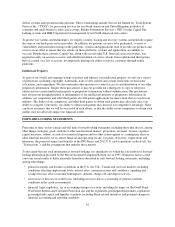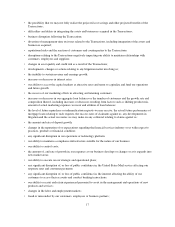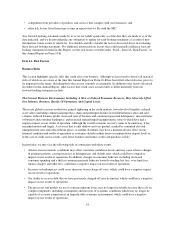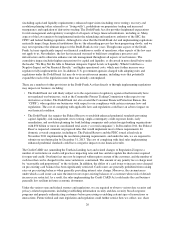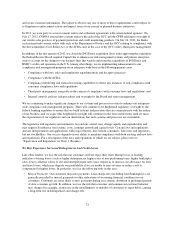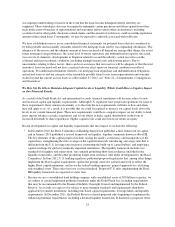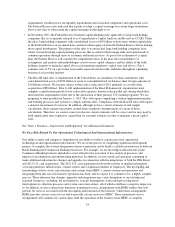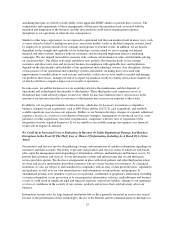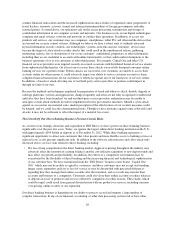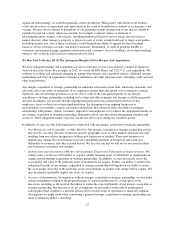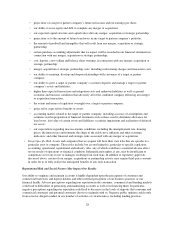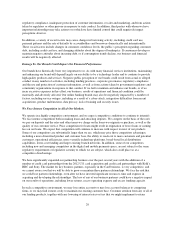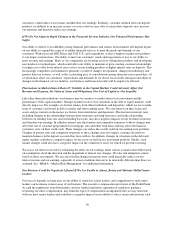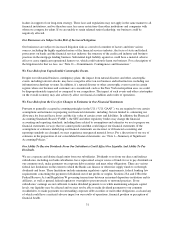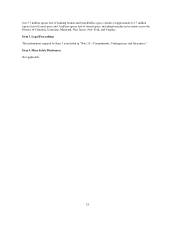Capital One 2012 Annual Report Download - page 42
Download and view the complete annual report
Please find page 42 of the 2012 Capital One annual report below. You can navigate through the pages in the report by either clicking on the pages listed below, or by using the keyword search tool below to find specific information within the annual report.was improper underwriting or fraud or in the event that the loans become delinquent shortly after they are
originated. These subsidiaries also may be required to indemnify certain purchasers and others against losses they
incur in the event of breaches of representations and warranties and in various other circumstances, including
securities fraud or other public disclosure-related claims, and the amount of such losses could exceed the repurchase
amount of the related loans. Consequently, we may be exposed to credit risk associated with sold loans.
We have established reserves in our consolidated financial statements for potential losses that are considered to
be both probable and reasonably estimable related to the mortgage loans sold by our originating subsidiaries. The
adequacy of the reserve and the ultimate amount of losses incurred will depend on, among other things, the actual
future mortgage loan performance, the actual level of future repurchase and indemnification requests, the actual
success rate of claimants, developments in litigation related to us and the industry, actual recoveries on the
collateral and macroeconomic conditions (including unemployment levels and housing prices). Due to
uncertainties relating to these factors, there can be no assurance that our reserves will be adequate or that the total
amount of losses incurred will not have a material adverse effect upon our financial condition or results of
operations. For additional information related to our mortgage loan repurchase and indemnification obligations
and related reserves and our estimate of the reasonably possible future losses from representation and warranty
claims beyond the current accrual levels as of December 31, 2012, see “Note 21—Commitments, Contingencies
and Guarantees.”
We May Not Be Able to Maintain Adequate Capital Levels or Liquidity, Which Could Have a Negative Impact
on Our Financial Results.
As a result of the Dodd-Frank Act and international accords, financial institutions will become subject to new
and increased capital and liquidity requirements. Although U.S. regulators have proposed regulations for some of
these requirements, there remains uncertainty as to the form the new requirements will take or how and when
they will apply to us. As a result, it is possible that we could be required to increase our capital levels above the
levels in our current financial plans. These new requirements could have a negative impact on our ability to lend,
grow deposit balances or make acquisitions and on our ability to make capital distributions in the form of
increased dividends or share repurchases. Higher capital levels could also lower our return on equity.
Recent developments in capital and liquidity requirements that may impact us include the following:
• In December 2010, the Basel Committee on Banking Supervision published a final framework on capital
and in January 2013 published a revised framework on liquidity, together commonly known as Basel III.
The key elements of the capital proposal include: raising the quality, consistency and transparency of the
capital base; strengthening the risk coverage of the capital framework; introducing a leverage ratio that is
different from the U.S. leverage ratio measures; promoting the build-up of capital buffers; and imposing a
capital surcharge for global systemically important institutions. The liquidity framework includes two
standards for liquidity risk supervision, one standard promoting short-term resilience (included in the
liquidity framework), and the other promoting longer-term resilience (still under development by the Basel
Committee). In June 2012, U.S. banking regulators published proposed regulations that, among other things,
implement the Basel capital requirements; update the prompt corrective action framework to reflect the
higher Basel capital minimums; and revise the federal banking agencies’ general approach for calculating
risk-weighted assets. These rules have not yet been finalized. Proposed U.S. rules implementing the Basel
III liquidity framework are expected at a later date.
• Because we are a consolidated bank holding company with consolidated assets of $50 billion or greater, we
are subject to certain heightened prudential standards under the Dodd-Frank Act, including requirements
that may be recommended by the Financial Stability Oversight Council and implemented by the Federal
Reserve. As a result, we expect to be subject to more stringent standards and requirements than those
applicable for smaller institutions, including risk-based capital requirements, leverage limits and liquidity
requirements. In December 2011, the Federal Reserve released proposed rules beginning to implement the
enhanced prudential requirements, including a detailed liquidity framework. If finalized as proposed, these
23





